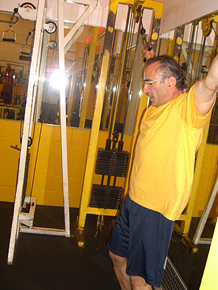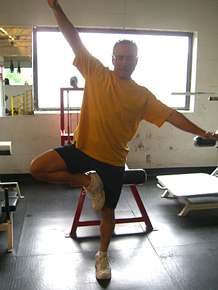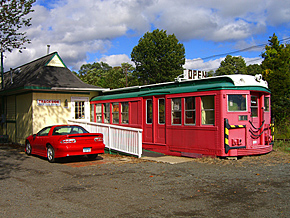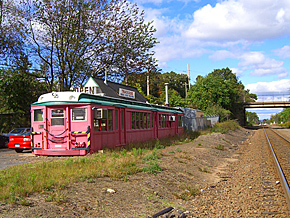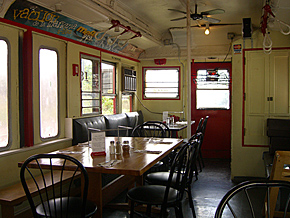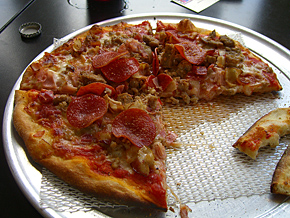North America Dispatch #36: Body by Jim, Plus Astounding Ecuadorian Railroad Pizza
Wallingford, Connecticut
I’m at T-minus 24 hours to winetasting. Oh, I didn’t tell you: Tomorrow I’ll be drinking glass after glass of priceless Bordeaux atop a mountain in New Hampshire. I explain how the hell I ever came to be invited in this podcast, titled “The Tale of Jack and Thelma”: MP3.
Here are the port wine tasting notes mentioned in the podcast.
My friend Jim (who’s also attending) helps explain exactly what we’ll be tasting in this podcast: MP3.
I’m facing a massive ingestion of foie gras and buttery food—plus all that alcohol (we’ll only be spitting merely wonderful wines; the rest will go down the hatch … after much swirling, swooshing, and furrowed eyebrows). Looking ahead to an umpteen-zillion-calorie weekend, I clearly need a vigorous workout, and Jim has agreed to whup my chow-touring butt into shape. We met at his gym, where he put me through a series of tortures specifically tailored to the rigors to come. We did exercises to firm me up for cork pulling, glass hoisting, etc.
Click on the photos and video (below) of Jim demonstrating the “wine-lover’s workout” while you listen to this podcast (MP3), a pastiche of treasured moments from my pathetic follow-through (yes, that’s me howling like a wolverine):
In this short video, Jim works “to failure”: Movie file.
I tortured Jim back by making him try some yoga:
+ + +
Armed with a cardio mandate from my triumphant workout, I’d earned some capital and intended to spend it. My thoughts turned to pizza.
Wallingford, Connecticut, just north of New Haven, is an interesting area I’d been wanting to check out. I got incredibly lucky, stumbling upon Trackside Pizza (118 Dudley Avenue, Wallingford, Connecticut; 203-697-1081). It’s invisible from the main road (Route 5), hidden in a ravine down next to the railroad tracks.
Trackside has it all. You dine in a real railroad car, alongside the tracks …
... and the pizza is superb—the equal of any in New Haven (I had the seafood combo, brimming with impeccably fresh shellfish) ...
... and the owners, sweet folks from Ecuador, are very friendly and genuine. The sheer unique coolness of eating phenomenal pizza in a charming, tidy railroad car staffed by Ecuadorans stuns customers out of their dining glaze. Strangers talk to each other. A couple of chowhoundish truckers even let me take a photo of their pie:
Here’s my theory (to be verified on some future visit): I think the owners worked at top pizzerias in New Haven, saved up, and have applied their pizza know-how here in their own place. And I’m thrilled. It’s dismaying that so many Mexican, Central American, and South American chefs cook so much of the most highly regarded food in this country with nary a speck of credit. How fantastic to see a few breaking out.
Whatever their origins, this much is clear: These guys are preserving the New Haven pizza tradition far more diligently than the present regimes at Sally’s, Pepe’s, or Modern (the Big Three), all of which are shadows of their former selves.
I also quickly sampled Louie’s Pizza (552 North Colony Road, Wallingford, Connecticut; 203-265-0161), which has been baking pies since 1960. Like Tony’s Baltimore Grill of Atlantic City (see report #6), it makes lived-in pizza. You can really taste the tradition. But it’s no match for the riveting grandeur of Trackside.
Grand Apizza North (448 Washington Avenue, North Haven, Connecticut; 203-239-5786) looked good but was closed when I passed it.
There’s so much good pizza around here. South-central Connecticut is like a ride—one ought to be charged just to enter the region. Why don’t more New Yorkers ply through here to recontact with the sort of proud pizza heritage we’ve so utterly lost?
+ + +
As mentioned in podcast #1, here are my
Grahams Port Wine Tasting Notes
Please bear in mind that the tasting described below took place in 1995, so significant changes have occurred with all the more recent vintages. In other words, these notes are for entertainment purposes only!
I started with the ‘77. Very young, syrupy, and grapey, the fruity taste about a mile away from the alcoholic kick. A good port to chat over (which people did quite a bit of, although they inexplicably were able to keep up their patter even over the older, more artistic ports. I don’t understand how—I retreated to a corner as I reached older vintages, my ecstatic grin reassuring the concerned hosts that all was well).
The ‘70 was a bit drier and cleaner tasting, though the alcoholic kick was still somewhat crude and unbalanced. The port hadn’t found itself yet, though there was a bit of a story in the finish, which receded with a plum taste.
The ‘66 made one nod one’s head: OK, here we go. This is port. An incredible aroma, the mouthfeel all silky and subtle. The alcohol played games—pulling and retracting throughout the story like a crazed taffy-pulling machine. Finish was elegant and left no fruitiness, although like the other young ports, there was a bit of cloying cotton candy hovering over everything.
My host Eugene seemed excited about this one, and I understand why. Fine port, though not so venerable as to be exorbitantly expensive. Much better, also, than the two older ports that followed.
‘63 was cagey, overly subtle. You had to find the port yourself, but with effort you could uncover virtually anything you sought inside the guarded flavor. Sipped absentmindedly, it had as much interest as the cardiogram of a corpse. Dig down for alcohol, and a cannon shoots straight for your nose. Look for a finish and ye shall find. I managed to deeply concentrate on about 2 of my 20 or so sips, and found a delicate, rippling effect in the finish that was quite beautiful; it lasted far longer than the in-mouth flavor. The only word for this port is Japanese—it was as elusive, delicate, provocative, and fleetingly beautiful as any Japanese brush painting.
But I didn’t want to work so hard. I wanted waves of cresting flavor to knock me over. I’m American, not Japanese.
Weird note: I’m a musician, and I find that when port is good, it has a tempo. I can nod my head to it; I can almost dance to it. The pace at which the flavors crest and fall in a great port is very rhythmic to me. The ‘66 was bopping, but the ‘63 didn’t swing at all.
‘55 had a big wallop of cotton candy, and I found it listless and inelegant.
‘48 was bliss. I poured myself into my glass and swallowed. Smoky, buttery, huge landscapes of crazy sensual flavors, some big, some almost subliminal, all changing and switching around. Still the cotton candy, but that was just the outside layer of a hugely complex petticoat. I noticed the stuff was rather brown, so it may be that I just LIKE oxidation (hey, I’ve enjoyed some infected beers as well), but great cheese ain’t so pure and sterile either, folks. My only complaint: The finish was a bit sudden. The show’s over before you expect, but it’s cool because you WANT to be left alone to work through your feelings about this sublime stuff.
Eugene seemed amused—and understanding—of my happiness at this point, and was excited for me to try the ‘45 (I was anxious to get some before it was all gone; wine honcho after wine honcho had gone straight for the good stuff, which they drank in a blasé fashion—do wine people always condescend to ports like this?).
I was amazed to find no brown in the color of the ‘45. As purple as last year’s batch. The aroma was stately, and the flavor described a straight line to me: no fireworks and digressions like the ‘48, just a controlled, direct path, shimmering with refined, bristling energy. Strange thing: This was one of the only drinks I’ve tried where I could send the alcohol up to my nose and then rein it back in in full bloom. Response like a Ferrari’s. The finish, like the ‘48, went thud, but then further waves came, so subtle as to call into question whether they were drink based or psyche based.
What a difference three years makes! The ‘45 and ‘48 were utterly different. The ‘45 was incredibly strong in its statement, never wavering, never yielding. While the ‘48 seemed capable of being experienced in subjectively different ways by different people (though not so much as the mirrorlike ‘63), the ‘45 took you on its trip and planted you firmly on the ground. The kind of thing that wins contests and earns the praise of experts.
I liked the ‘48 better.
After all this, I returned to the ‘66, which Eugene was touting as the poor man’s ‘45 (with talk going on like “If I spend less than a thousand on a bottle, I have no problem just drinking it,” I figured this vintage had my name on it). Revisited after the good stuff, the ‘66 seemed crude. All the elements were all there, but nothing had come together yet. Sort of like a country street lined with not-quite-mature trees, their branches struggling to touch, to provide a canopy, but not quite making it yet.
A snob for the evening, I discarded my 1/4 glassful and called it a night.
« Previous Post: Fun in Bethel, Serious Scores in New Haven«
»Next Post: Bordeaux Out to Here »


